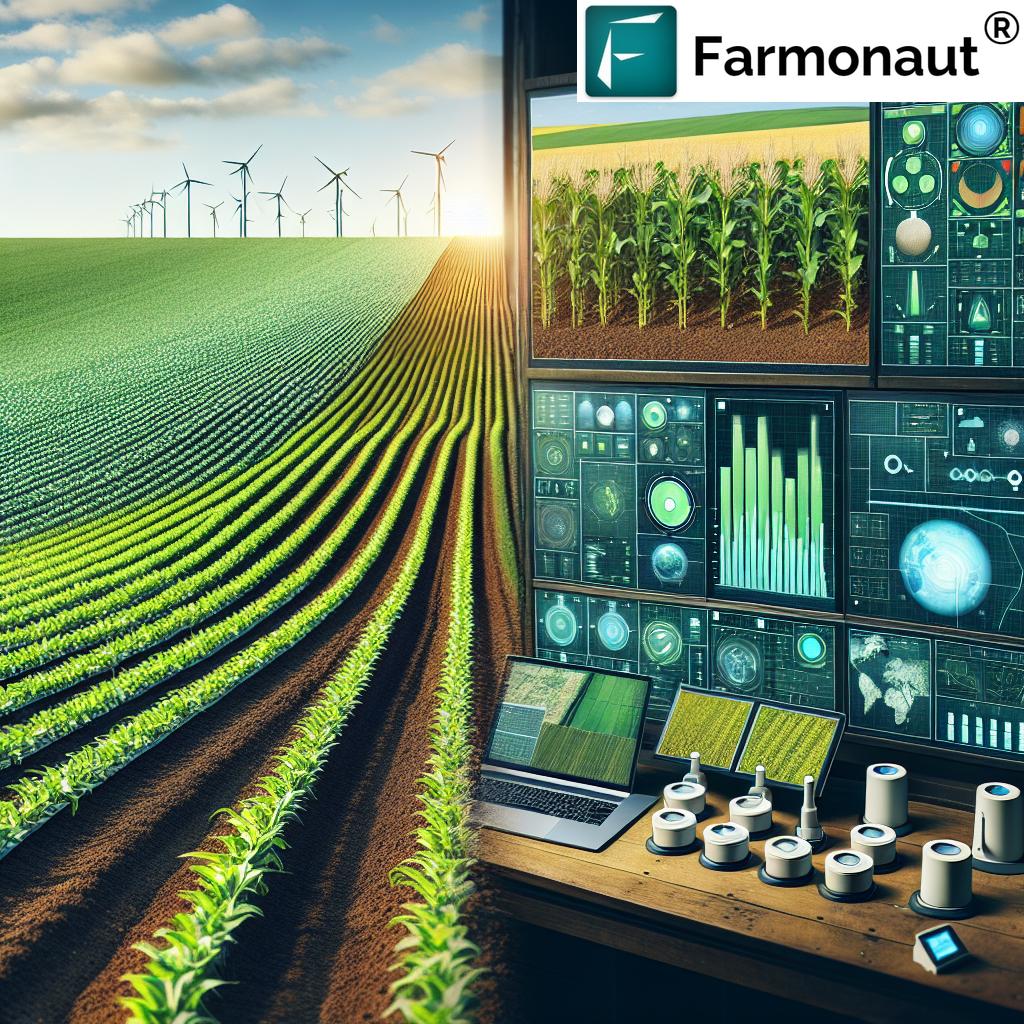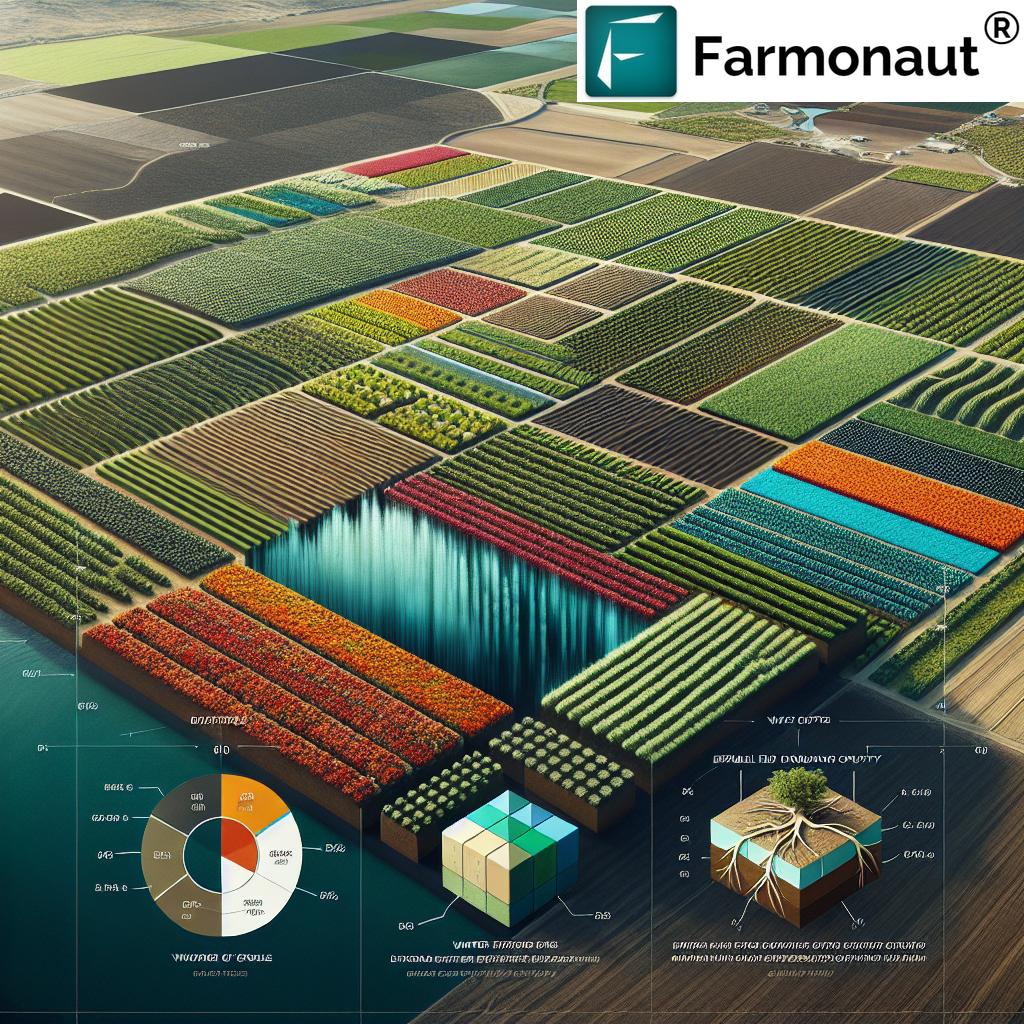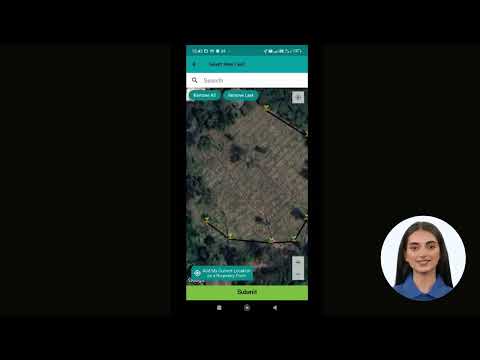Revolutionize Your Crop Yield: Master Soil Moisture Monitoring for Precision Irrigation Management
In the ever-evolving world of agriculture, we’re witnessing a revolution in crop yield optimization through advanced soil moisture monitoring and precision irrigation management. As farmers and agricultural professionals, we understand the critical role that water plays in crop development. Today, we’ll dive deep into the innovative techniques and technologies that are transforming agricultural water management, helping us achieve unprecedented levels of efficiency and productivity.

“Precision irrigation management can increase crop yields by up to 25% while reducing water usage by 30%.”
At Farmonaut, we’re at the forefront of this agricultural revolution, providing cutting-edge solutions that make precision agriculture accessible and affordable for farmers worldwide. Our satellite-based farm management platform integrates innovative technology with data-driven insights, empowering farmers to make informed decisions and optimize their crop yields.
Understanding Soil Moisture Monitoring
Soil moisture monitoring is a cornerstone of effective agricultural water management. By accurately measuring the water content in soil, we can make precise decisions about when and how much to irrigate our crops. This practice is essential for several reasons:
- Optimizing water usage
- Preventing over-irrigation and waterlogging
- Minimizing nutrient leaching
- Reducing energy costs associated with irrigation
- Improving crop health and yield
To fully leverage the benefits of soil moisture monitoring, it’s crucial to understand the concept of soil water holding capacity. This refers to the amount of water that soil can retain against gravity, which varies depending on soil texture, structure, and organic matter content.
Defining Irrigation Block Boundaries
An essential step in implementing precision irrigation management is defining irrigation block boundaries. Irrigation blocks are areas within a field that have similar soil characteristics, topography, and crop water requirements. By dividing our fields into these blocks, we can tailor our irrigation strategies to meet the specific needs of each area, maximizing efficiency and crop yield.
To define irrigation blocks effectively, we need to consider:
- Soil texture and composition
- Slope and drainage patterns
- Crop varieties and growth stages
- Available water sources and irrigation system capabilities
Farmonaut’s satellite-based crop health monitoring system can assist in this process by providing detailed maps of field variability, helping us identify areas with similar characteristics for optimal block design.
Assessing Soil Water Holding Capacity
Understanding the soil water holding capacity is crucial for effective irrigation management. This capacity is influenced by several factors:
- Soil texture (sand, silt, clay content)
- Soil structure
- Organic matter content
- Depth of the root zone
To assess soil water holding capacity, we can use various methods:
- Soil sampling and laboratory analysis: This provides accurate results but can be time-consuming and expensive.
- Soil texture analysis: By determining the percentages of sand, silt, and clay, we can estimate water holding capacity.
- Field capacity tests: These involve saturating the soil and measuring water content after excess water has drained.
- Remote sensing techniques: Satellite imagery and spectral analysis can provide insights into soil moisture levels across large areas.
Farmonaut’s platform utilizes advanced satellite imagery to help farmers assess soil moisture levels and water holding capacity across their fields, providing valuable data for irrigation planning.
Establishing Irrigation Thresholds
Once we understand our soil’s water holding capacity, the next step is to establish irrigation thresholds. These thresholds help us determine when to irrigate and how much water to apply. Two critical points to consider are:
- Field Capacity (FC): The maximum amount of water the soil can hold against gravity.
- Permanent Wilting Point (PWP): The moisture level at which plants can no longer extract water from the soil.
The range between FC and PWP is known as the Plant Available Water (PAW). To optimize irrigation, we typically aim to maintain soil moisture within the upper portion of this range, known as the Management Allowable Depletion (MAD). The MAD varies depending on crop type and growth stage but is generally set between 30% to 50% of PAW for most crops.
| Crop Type | Field Capacity (% soil moisture) | Management Allowable Depletion (%) | Wilting Point (% soil moisture) |
|---|---|---|---|
| Corn | 30-35 | 50-60 | 12-15 |
| Soybeans | 28-32 | 40-50 | 10-12 |
| Wheat | 25-30 | 50-60 | 9-11 |
| Vegetables | 25-35 | 30-40 | 8-12 |
By setting appropriate irrigation thresholds, we can ensure that our crops receive adequate water while avoiding waste and potential negative impacts of over-irrigation.
Soil Moisture Sensor Installation
To accurately monitor soil moisture levels, the installation of soil moisture sensors is crucial. These devices provide real-time data on soil water content, enabling us to make informed irrigation decisions. Here’s a guide to effective sensor installation:
- Choose the right sensor type: Options include capacitance probes, tensiometers, and neutron probes. Select based on accuracy needs, soil type, and budget.
- Determine sensor placement: Install sensors at multiple depths within the root zone and in representative areas of each irrigation block.
- Ensure proper contact: Good soil-sensor contact is essential for accurate readings. Avoid air pockets during installation.
- Calibrate sensors: Calibrate each sensor to your specific soil type for precise measurements.
- Integrate with data logging systems: Connect sensors to data loggers or wireless networks for continuous monitoring and easy access to information.
Farmonaut’s platform can integrate data from various soil moisture sensors, providing a comprehensive view of soil water status across your fields. This integration allows for more precise irrigation management and decision-making.

Calculating Plant Available Water
Accurately calculating Plant Available Water (PAW) is essential for effective irrigation management. PAW represents the amount of water in the soil that plants can access. To calculate PAW, we use the following formula:
PAW = (FC – PWP) * Root Zone Depth
Where:
- FC = Field Capacity (volumetric water content)
- PWP = Permanent Wilting Point (volumetric water content)
- Root Zone Depth = Depth of the soil profile where roots are active
By monitoring PAW and comparing it to our established irrigation thresholds, we can determine the optimal timing and amount of irrigation to apply.
Leveraging Advanced Software for Precision Farming
In the era of digital agriculture, leveraging advanced software is key to maximizing the benefits of soil moisture monitoring and precision irrigation. Farmonaut’s platform offers a suite of tools designed to enhance agricultural decision-making:
- Satellite-Based Crop Health Monitoring: Our system uses multispectral satellite imagery to provide insights into vegetation health (NDVI), soil moisture levels, and other critical metrics.
- Jeevn AI Advisory System: This AI-driven tool delivers personalized farm advice, including irrigation recommendations based on real-time data and weather forecasts.
- Resource Management Tools: Our software helps optimize water usage by integrating soil moisture data with other relevant information such as weather patterns and crop growth stages.
By utilizing these advanced tools, farmers can make data-driven decisions that lead to improved water use efficiency, reduced input costs, and ultimately, higher crop yields.
“Soil moisture sensors can detect water content changes as small as 0.1%, enabling ultra-precise irrigation control.”
Implementing Precision Irrigation Techniques
With a solid understanding of soil moisture monitoring and the right tools at our disposal, we can implement precision irrigation techniques that significantly improve water use efficiency and crop yields. Here are some key strategies:
- Variable Rate Irrigation (VRI): Adjust water application rates based on soil moisture variability within irrigation blocks.
- Deficit Irrigation: Strategically reduce irrigation during less sensitive growth stages to improve water use efficiency without significantly impacting yield.
- Scheduling Based on Crop Water Demand: Use crop coefficients and evapotranspiration data to match irrigation timing and amounts to actual crop water needs.
- Soil Moisture-Based Automation: Integrate soil moisture sensors with irrigation control systems for automated water application based on real-time soil moisture levels.
Implementing these techniques requires careful planning and continuous monitoring, but the results can be transformative for farm productivity and sustainability.
Preventing Crop Diseases through Proper Irrigation
Effective irrigation management not only optimizes water use but also plays a crucial role in preventing crop diseases. Many plant pathogens thrive in overly wet conditions, making proper water management essential for disease control. Here’s how precision irrigation helps:
- Reduces leaf wetness duration, limiting fungal disease development
- Prevents waterlogging, which can lead to root diseases
- Maintains optimal soil moisture levels, supporting plant health and natural disease resistance
- Allows for precise timing of irrigation to avoid creating favorable conditions for disease outbreaks
By leveraging Farmonaut’s crop health monitoring and AI advisory system, farmers can receive early warnings about potential disease risks and adjust their irrigation strategies accordingly.
Maximizing ROI through Precision Irrigation Management
Implementing precision irrigation management can significantly improve a farm’s Return on Investment (ROI). Here’s how:
- Reduced Water Costs: By applying water only when and where it’s needed, farmers can substantially reduce water usage and associated pumping costs.
- Improved Crop Yields: Maintaining optimal soil moisture levels throughout the growing season can lead to higher yields and better crop quality.
- Decreased Input Costs: Precise irrigation can improve nutrient uptake efficiency, potentially reducing fertilizer requirements.
- Energy Savings: Optimized irrigation schedules can lead to reduced pumping time and lower energy consumption.
- Disease Prevention: By avoiding overwatering, farmers can reduce the incidence of water-related crop diseases, saving on pesticide costs.
Farmonaut’s platform helps farmers track these improvements, providing data-driven insights into the financial benefits of precision irrigation management.
Adapting Irrigation Strategies for Different Crop Types
Different crops have varying water requirements and sensitivities to water stress. Adapting irrigation strategies to specific crop needs is essential for maximizing yields and water use efficiency. Let’s explore irrigation considerations for some common crop types:
Vineyards
Grape vines are often managed with deficit irrigation strategies to improve fruit quality. Key considerations include:
- Timing irrigation to critical growth stages (e.g., fruit set, veraison)
- Implementing Regulated Deficit Irrigation (RDI) to enhance fruit quality
- Monitoring soil moisture at multiple depths due to deep root systems
Orchards
Fruit trees require careful water management to optimize fruit size and quality. Important factors include:
- Adjusting irrigation based on tree age and size
- Considering fruit development stages when scheduling irrigation
- Using soil moisture sensors to monitor water distribution in the root zone
Berry Fields
Berries often have shallow root systems and high water demands. Key irrigation strategies include:
- Maintaining consistent soil moisture to prevent stress and fruit quality issues
- Using drip irrigation or micro-sprinklers for precise water application
- Adjusting irrigation frequency based on weather conditions and growth stage
Farmonaut’s crop-specific monitoring and advisory services can help farmers tailor their irrigation strategies to the unique needs of their crops, ensuring optimal water use and yield potential.
The Future of Precision Irrigation: AI and Automation
As we look to the future, the integration of Artificial Intelligence (AI) and automation in precision irrigation systems promises to revolutionize agricultural water management further. Here’s what we can expect:
- AI-Driven Irrigation Scheduling: Advanced algorithms will analyze multiple data points, including soil moisture, weather forecasts, and crop growth models, to optimize irrigation timing and amounts.
- Predictive Analytics: AI systems will forecast crop water needs and potential stress conditions, allowing for proactive irrigation management.
- Automated Irrigation Systems: Smart irrigation controllers will adjust water application in real-time based on sensor data and AI recommendations.
- Drone and Satellite Integration: High-resolution imagery from drones and satellites will provide detailed insights into field variability and crop water status.
Farmonaut is at the forefront of these technological advancements, continuously developing and integrating new features to help farmers stay ahead in the rapidly evolving world of precision agriculture.
Conclusion: Embracing the Soil Moisture Monitoring Revolution
As we’ve explored throughout this comprehensive guide, mastering soil moisture monitoring and precision irrigation management is key to revolutionizing crop yields and achieving sustainable agriculture. By implementing the strategies and technologies discussed, farmers can significantly improve their water use efficiency, reduce input costs, and maximize their agricultural ROI.
Farmonaut’s innovative platform stands ready to support farmers in this journey, offering cutting-edge tools for satellite-based crop monitoring, AI-driven advisory services, and comprehensive farm management solutions. As we move forward, the integration of advanced technologies in agriculture will continue to open new possibilities for efficiency and productivity.
We encourage all farmers and agricultural professionals to embrace these precision agriculture techniques and technologies. By doing so, we can not only improve our individual farm operations but also contribute to a more sustainable and productive global agricultural system.
FAQ Section
Q: How often should I monitor soil moisture levels?
A: The frequency of soil moisture monitoring depends on various factors such as crop type, growth stage, and weather conditions. Generally, daily monitoring is recommended during critical growth stages or in periods of high water demand. For less sensitive periods, monitoring every 2-3 days may be sufficient.
Q: Can soil moisture monitoring help in drought conditions?
A: Yes, soil moisture monitoring is especially valuable during drought conditions. It helps farmers make informed decisions about water allocation, prioritize irrigation for the most critical areas, and implement effective water conservation strategies.
Q: How do I choose the right soil moisture sensor for my farm?
A: Consider factors such as soil type, crop requirements, budget, and desired accuracy. Capacitance probes are popular for their ease of use and continuous monitoring capabilities. Consult with agricultural extension services or precision agriculture experts for personalized recommendations.
Q: Can precision irrigation management be implemented on small farms?
A: Absolutely! While some advanced systems might require significant investment, there are scalable solutions suitable for small farms. Farmonaut’s platform, for instance, offers affordable satellite-based monitoring and AI advisory services that can benefit farms of all sizes.
Q: How does soil type affect irrigation management?
A: Soil type significantly influences water holding capacity and drainage characteristics. Sandy soils drain quickly and require more frequent irrigation, while clay soils retain water longer but are prone to waterlogging. Understanding your soil type is crucial for effective irrigation management.
By implementing these soil moisture monitoring and precision irrigation management techniques, farmers can take a significant step towards optimizing their crop yields and resource efficiency. Farmonaut’s advanced agricultural technology solutions are designed to support farmers in this journey, making precision agriculture accessible and affordable for operations of all sizes.
Ready to revolutionize your farm’s irrigation management? Explore Farmonaut’s comprehensive suite of precision agriculture tools:
For developers interested in integrating Farmonaut’s powerful agricultural data into their own applications, check out our API and API Developer Docs.
Farmonaut Subscriptions
Additional Resources
To further enhance your understanding of precision agriculture and soil moisture monitoring, check out these informative videos:
By leveraging the power of soil moisture monitoring and precision irrigation management, along with Farmonaut’s advanced agricultural technology solutions, farmers can truly revolutionize their crop yields while promoting sustainable farming practices. Embrace the future of agriculture today!






